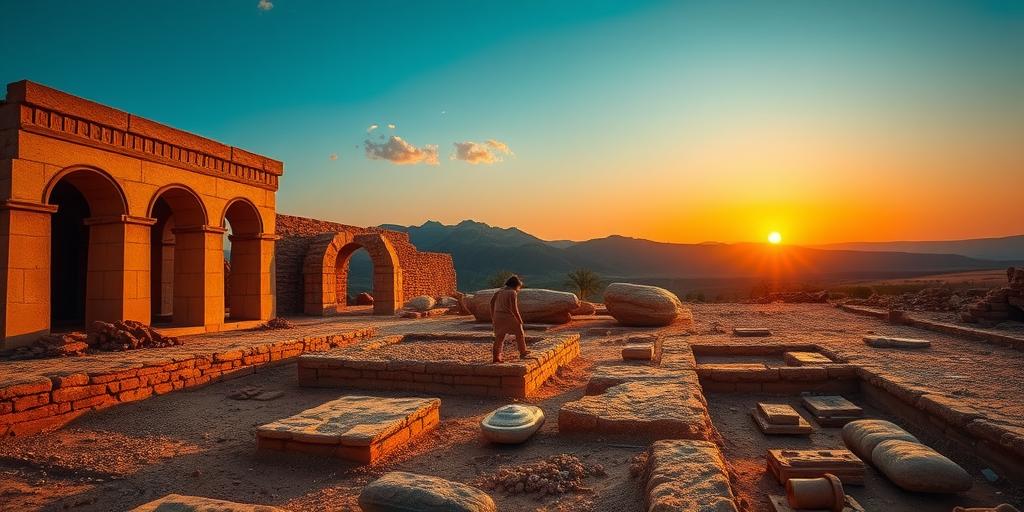Unearthing the Past: Archaeological Insights into Ancient Civilizations
Archaeology, the systematic study of past human life and activities by examining material culture, offers a unique window into ancient civilizations. Through meticulous excavation, analysis, and interpretation, archaeologists piece together the stories of societies long gone, revealing their technological advancements, social structures, belief systems, and daily lives.
The Significance of Archaeological Discoveries
Archaeological discoveries provide tangible evidence of past civilizations, supplementing and sometimes challenging historical texts. They allow us to understand the lived experiences of people who inhabited the world centuries ago, offering insights that written records often omit. These discoveries range from monumental architecture and intricate artwork to everyday tools and personal adornments, each contributing to a more complete picture of the past.
Key Archaeological Sites and Their Revelations
- Ancient Egypt: The pyramids of Giza, the Valley of the Kings, and the temples of Karnak stand as testaments to the advanced engineering, religious beliefs, and hierarchical society of ancient Egypt. Hieroglyphic inscriptions and artifacts found within tombs reveal details about pharaohs, gods, and the afterlife.
- Mesopotamia: The region between the Tigris and Euphrates rivers, known as Mesopotamia, is considered the cradle of civilization. Archaeological excavations at sites like Ur, Babylon, and Nineveh have unearthed cuneiform tablets, monumental ziggurats, and intricate cylinder seals, providing insights into the development of writing, law, and urban life.
- Ancient Greece: The Acropolis of Athens, the ruins of Delphi, and the palaces of Knossos offer glimpses into the art, philosophy, and political systems of ancient Greece. Pottery shards, sculptures, and architectural fragments reveal the aesthetic values and intellectual achievements of this influential civilization.
- Roman Empire: From the Colosseum and the Forum in Rome to the ruins of Pompeii and Herculaneum, archaeological sites across the Roman Empire showcase the empire's vast infrastructure, military power, and cultural diversity. Excavations have uncovered well-preserved buildings, roads, aqueducts, and artifacts that shed light on Roman daily life, trade, and governance.
- Maya Civilization: Hidden within the jungles of Central America, the Maya civilization left behind impressive cities like Tikal, Chichen Itza, and Palenque. Archaeological investigations have revealed intricate temples, pyramids, and ballcourts, along with hieroglyphic inscriptions and sophisticated astronomical knowledge, demonstrating the Maya's advanced mathematics, calendrical systems, and religious practices.
Methods and Techniques in Archaeology
Archaeologists employ a variety of methods and techniques to uncover and interpret the past:
- Excavation: Carefully digging and documenting layers of soil and artifacts to reveal the stratigraphy of a site.
- Survey: Mapping and documenting surface features and artifacts to identify potential excavation sites.
- Dating Techniques: Using methods like radiocarbon dating, dendrochronology, and thermoluminescence to determine the age of artifacts and sites.
- Artifact Analysis: Studying the materials, manufacturing techniques, and use-wear patterns of artifacts to understand their function and significance.
- Remote Sensing: Employing technologies like aerial photography, satellite imagery, and ground-penetrating radar to identify subsurface features and map archaeological landscapes.
Challenges and Ethical Considerations
Archaeology faces several challenges, including looting, site destruction, and the ethical considerations of excavating and displaying human remains and sacred objects. Archaeologists must work closely with local communities, governments, and cultural heritage organizations to protect archaeological sites, promote responsible excavation practices, and ensure the respectful treatment of cultural heritage.
Conclusion
Archaeology provides invaluable insights into the lives, achievements, and challenges of ancient civilizations. By studying material culture, archaeologists piece together the stories of the past, offering a deeper understanding of human history and cultural diversity. As new technologies and methodologies emerge, archaeology will continue to play a vital role in uncovering the secrets of the past and preserving cultural heritage for future generations.









